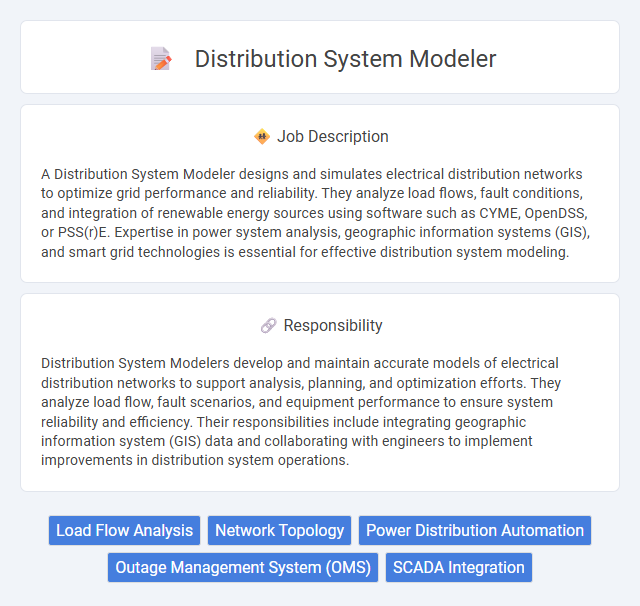
A Distribution System Modeler designs and simulates electrical distribution networks to optimize grid performance and reliability. They analyze load flows, fault conditions, and integration of renewable energy sources using software such as CYME, OpenDSS, or PSS(r)E. Expertise in power system analysis, geographic information systems (GIS), and smart grid technologies is essential for effective distribution system modeling.
Individuals with strong analytical skills and a background in electrical engineering or power systems are likely suitable for a Distribution System Modeler role. Candidates who enjoy working with complex data, modeling software, and simulation tools may find the job fulfilling and well-aligned with their interests. Those who prefer routine tasks or lack proficiency in technical problem-solving might face challenges adapting to this position.
Qualification
A Distribution System Modeler requires a strong background in electrical engineering, particularly in power distribution systems, alongside proficiency in simulation software such as CYME or OpenDSS. Expertise in analyzing and modeling electrical distribution networks, understanding load flow, fault analysis, and protection coordination is essential for accurate system design and optimization. Advanced skills in data analytics, GIS mapping, and familiarity with industry standards like IEEE and NERC improve the modeler's ability to create reliable and efficient distribution system models.
Responsibility
Distribution System Modelers develop and maintain accurate models of electrical distribution networks to support analysis, planning, and optimization efforts. They analyze load flow, fault scenarios, and equipment performance to ensure system reliability and efficiency. Their responsibilities include integrating geographic information system (GIS) data and collaborating with engineers to implement improvements in distribution system operations.
Benefit
The Distribution System Modeler likely enhances the accuracy of power grid simulations, improving reliability and efficiency in energy distribution. This role probably supports better identification of system vulnerabilities, leading to reduced downtime and maintenance costs. Employers may benefit from optimized resource allocation and informed decision-making based on comprehensive distribution models.
Challenge
The Distribution System Modeler role likely involves the challenge of accurately representing complex electrical distribution networks to ensure optimal performance and reliability. Managing diverse data sources and integrating real-time information may pose significant difficulties in building and maintaining these models. Navigating the evolving standards and technologies in power distribution systems could further complicate the modeling process.
Career Advancement
A Distribution System Modeler develops and maintains simulation models for electrical distribution networks, enabling accurate analysis and optimization. Expertise in software tools such as CYME, Synergi Electric, or OpenDSS enhances career growth opportunities in utility companies and engineering consultancies. Advancing to roles like Senior Engineer or Distribution Planning Manager requires strong analytical skills, experience with smart grid technologies, and project leadership capabilities.
Key Terms
Load Flow Analysis
A Distribution System Modeler specializing in Load Flow Analysis develops and analyzes electrical distribution networks to ensure efficient power delivery and stability. They utilize advanced simulation software to model voltage profiles, power losses, and load demands, optimizing network configurations for reliability and capacity. Expertise in transformer settings, feeder configurations, and fault analysis supports accurate prediction and resolution of load flow issues in complex distribution systems.
Network Topology
A Distribution System Modeler specializes in creating and maintaining accurate network topology models to optimize the configuration and performance of electrical distribution systems. They analyze connectivity, equipment placement, and load flow to ensure reliable and efficient power delivery across substations, feeders, and transformers. Expertise in GIS integration and advanced modeling software enables precise simulation and impact assessment of network changes on system stability.
Power Distribution Automation
A Distribution System Modeler specializing in Power Distribution Automation designs and simulates electrical grids to optimize energy flow and improve reliability in utility networks. Expertise in advanced software tools like CYME, OpenDSS, or GridLAB-D is essential for creating accurate models that support automated fault detection, isolation, and service restoration (FDIR) processes. Proficiency in analyzing real-time data from smart grid sensors and integrating distributed energy resources (DERs) enhances grid efficiency and resilience.
Outage Management System (OMS)
A Distribution System Modeler specializing in Outage Management System (OMS) develops and maintains accurate models of electrical distribution networks to enhance outage detection, response, and restoration processes. They integrate OMS data with Geographic Information Systems (GIS) and Supervisory Control and Data Acquisition (SCADA) systems to improve real-time situational awareness and optimize outage prediction algorithms. Expertise in load flow analysis, network topology, and fault analysis is critical for supporting utilities in minimizing outage durations and improving overall grid reliability.
SCADA Integration
Distribution System Modeler specializes in creating accurate digital representations of electrical distribution networks to optimize performance and reliability. Expertise in SCADA integration enables seamless real-time data acquisition and control, enhancing system monitoring and rapid fault detection. Proficiency in data synchronization between GIS platforms and SCADA systems ensures efficient operation and improved decision-making for utility management.
 kuljobs.com
kuljobs.com